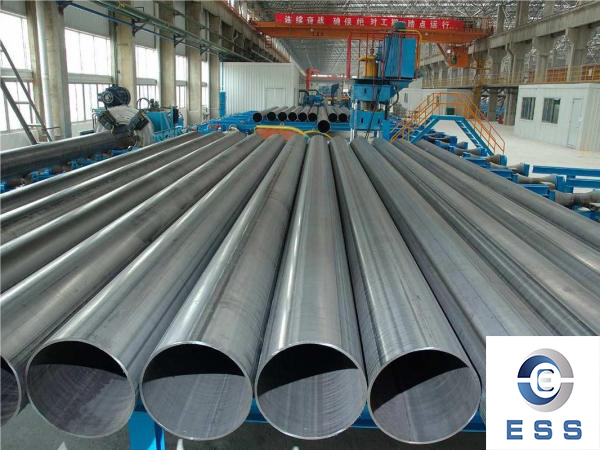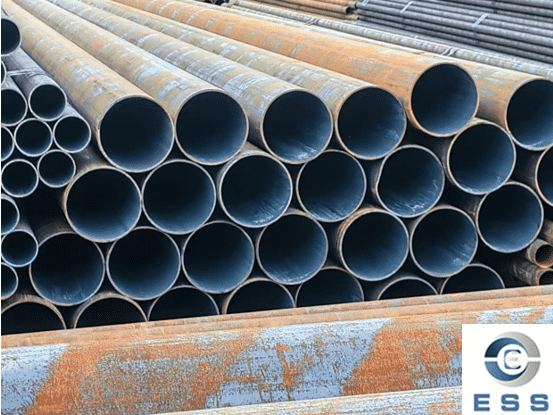What are the main equipment in the erw pipe production line?
1. Uncoiler
The hot-rolled steel coil is disassembled and sent to the leveling machine. It is divided into two unwinding methods: upper unwinding and lower unwinding.
2. Steel strip leveling machine
The strip is leveled before forming. Generally, it is composed of upper machine base, lower machine base, transmission device, etc., and there are five rollers, seven rollers, etc. In the welded pipe production line, there are usually pinch rollers before the leveler.

3. Head cutting butt welding machine
In order to ensure the continuous production of the production line, the irregular head and tail ends of the front and rear strips need to be trimmed neatly by a shear butt welder, clamped in the center and welded together to form strips that can be continuously produced.
4. Storage looper
In order to meet the continuous production of welded steel tubes, a looper storage device must be installed before the strip head and tail shear butt welding station. When the strip steel is being uncoiled, the head and tail are cut and butt welded, the looper can continuously convey the pre-stored strip steel to ensure the continuous production of the unit.
5. Horizontal looper
The horizontal spiral looper is suitable for the strip steel thickness range of 0.4-16mm, and the suitable pipe specification is 14-610mm. The horizontal looper is mainly composed of inlet guide device, filling material and its transmission system, inner and outer roller cages, center roller system, and outlet guide device. The main advantages are that it can be filled at any time, the deformation of the strip steel is small, and the maintenance is convenient.
6. Disc shears
Both sides of the strip are sheared and trimmed to meet the requirements of the forming machine for the width and straightness of the strip. Its main components include cutting edge, cutting edge shaft, width adjustment mechanism, weight adjustment and clearance mechanism, upper and lower guide rollers, transmission mechanism, etc.
7. Edge milling machine
For steel strips above 10mm, in order to ensure the welding quality, it is necessary to mill the edge of the steel strip to obtain a certain geometric shape and size of the strip edge, which is conducive to welding. The equipment is mainly composed of two groups of milling cutters arranged horizontally on both sides of the strip, a control system, a transmission system, etc. Can greatly improve welding quality and reduce material consumption
8. Forming machine
Straight Seam Resistance Roll Forming Machine
9. Roller
The roll is the main mold for the production of high-frequency welded pipe and cold-formed steel, and is the main consumable part. The types of rolls are divided into cast rolls and forged rolls according to the manufacturing method; according to the process method, they are divided into integral rolls and combined rolls. Its quality directly affects product quality, output and cost.
A good roll should contain three aspects:
① According to the deformation law of the strip steel, the pass design is carried out to ensure the forming quality:
②The roll material must have high strength, high hardness, high wear resistance and toughness to ensure its long life;
③ According to the performance of the product, select the corresponding roll material, manufacturing method and manufacturing process to achieve practicality and economy.
10. High frequency welding device
Using the skin effect and proximity effect of high-frequency current, the metal to be welded can be rapidly heated to a molten state, and welding is realized by extrusion. High-frequency welding usually uses a current frequency range of 300-450KHZ, and a power of 100-1000KW. At present, the use of solid-state high-frequency welding machines is advocated.
11. Sizing machine
The sizing unit usually consists of several driving horizontal racks, passive vertical roll racks and correction devices, which ultimately ensure the accuracy of the outer diameter and cross-sectional shape of the steel pipe, and can also improve the stress concentration and residual stress in forming and welding production.
12. Internal burr removal
In the ERW welded pipe process, it is used to remove the weld burr in the welded pipe. Commonly used is the shaft diameter two-way hydraulic internal burr removal device. It is mainly composed of shaft, neck hydraulic cylinder, link mechanism and tool height adjustment mechanism. The cutting tool is preferably a ring knife.
13. Weld heat treatment
In the ERW welded pipe process, the weld including the heat-affected zone is normalized, or the weld is subjected to haggard fire + tempering and normalizing + tempering treatment. Make the metallographic structure and mechanical properties of the weld consistent with those of the base metal to eliminate welding stress and improve the performance of the weld. The most widely used is the intermediate frequency heat treatment machine.
14. Length cutting machine
The cut-to-length cutting machine is an important equipment for the continuous production line of pipes and profiles. Realize high-precision fixed-length cutting under the online running state of pipes and profiles. The cutting forms include sawing, rotary cutting and punching, and the drive system includes DC servo drive system and AC servo drive system, and the cut-to-length is controlled by a microcomputer.
15. Steel pipe straightening machine
Although the sizing device sets the shape in the radial direction, the steel pipe still has a certain degree of curvature in the length direction. For this reason, the steel pipe must be straightened, and the straightening machine is generally divided into a pressure straightening machine and a roller straightening machine. The working principle of the roller straightening machine is: the steel pipe moves straight forward between the oblique hyperboloid straightening rollers and also rotates, and the steel pipe achieves the purpose of straightening through repeated elastic-plastic bending of the steel pipe in the straightening rollers.
16. Pipe end flat head chamfering machine
The end of the pipe cut by the cutting machine generally leaves some notch defects and burrs. In order to meet the subsequent process and the user's requirements for the bevel, the burrs and inner and outer edges of the pipe end need to be trimmed. The flat head chamfering machine is the equipment used to mill the ends of the welded pipe to make it flat and chamfered. It is composed of steel pipe feeding device, steel pipe clamping device, knife holder, follower device, transmission device, frame body and other parts. The working process of the flat head chamfering machine can realize automatic continuous cycle and automatic control.
17. Hydraulic testing machine
Hydrostatic test is the main equipment for welded pipe production. A few days ago, the hydraulic testing machine used in the production of welded pipes has a working process of: feeding, clamping, filling, pressurizing, maintaining pressure, releasing pressure, and discharging. This process also constitutes the basic action cycle of the test tube hydraulic testing machine. Modern hydraulic testing machines are all controlled by PLC, so that each work process can be automatically completed in sequence, and it has the function of automatic recording of test result parameters. According to the sealing form, it can be divided into radial seal and end face seal. Radial sealing is to use a sealing ring that matches the inner diameter or outer diameter of the welded pipe, and the purpose of sealing the pipe wall is achieved through the expansion of the sealing ring under pressure. Its advantages are that the steel pipe is easy to clamp and pull out, the seal is reliable, the axial force of the steel pipe is small, and it is not easy to bend. However, the structure of the sealing head is more complicated, there are many specifications, and there is a blind area in the test at the end of the pipe. The end face seal is to rely on the sealing material and the end face of the nozzle to achieve the purpose of sealing the nozzle. Its advantages are simple test structure and good versatility, but it has higher requirements on the performance of the sealing material, the ratio of oil-water pressure difference and the servo control system.
18. Ultrasonic flaw detection
It is a non-destructive testing method for detecting internal defects of materials by using the principle that ultrasonic waves will diffract when encountering different density medium interfaces during propagation.
19. Eddy current testing
It is mostly used for online detection of small diameter ERW welded pipes. Because the probe does not contact the surface of the pipe, it can realize high-speed flaw detection. It is more sensitive to the detection of defects on the pipe surface, but it is not ideal for the detection of layer defects and inner surface defects. It can detect pipe body and weld defects, and can use impedance plane technology to analyze the position and depth of defects.
High frequency resistance welded steel pipe (ERW pipe) has the following characteristics
1.High-frequency resistance welding is a pressure welding method without filler metal.
2.High-frequency resistance welding has high welding speed and high production efficiency. Because the current energy is highly concentrated in the welding area, the heating speed is fast, so the welding speed is very high.
3.The welding heat-affected zone is small. Due to the high concentration of energy during welding, fast heating speed, high welding speed, and strong self-cooling effect of the workpiece, the heat-affected zone is small.
4.The technical level and management level of welding production are relatively high. Since the welding of high-frequency resistance welding is continuous production on a production line, the welding speed is high, the production efficiency is high, and there are many factors affecting the welding process, so it must have a high level of technology and management. Only in this way can the multiple elements of the welding production line be unified and coordinated to obtain high-quality welded steel pipes continuously and stably.
Summarize
The production of ERW pipes is already a mature technology. In addition to being widely used in land and sea oil well pipes and oil and gas transmission pipes, the development of ERW pipes has involved the use of steel pipes in cold areas of the base and in acidic medium conditions.













 Eastern Steel Manufacturing Co.,Ltd not only improve product production and sales services, but also provide additional value-added services. As long as you need, we can complete your specific needs together.
Eastern Steel Manufacturing Co.,Ltd not only improve product production and sales services, but also provide additional value-added services. As long as you need, we can complete your specific needs together.










